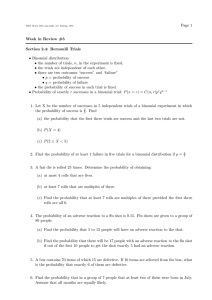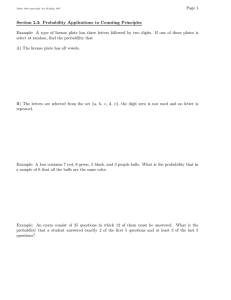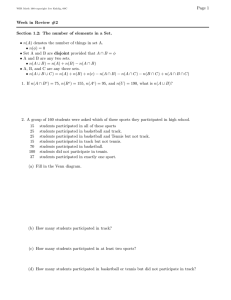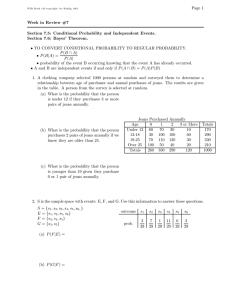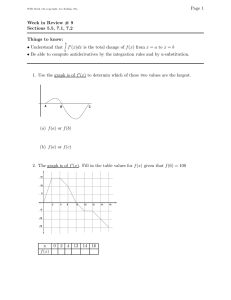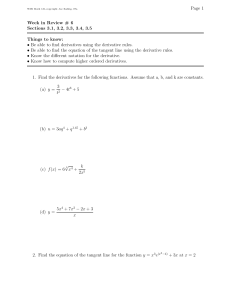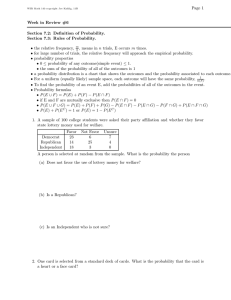Page 1 Week in Review #5 Section 2.4: Bernoulli Trials Binomial distribution
advertisement
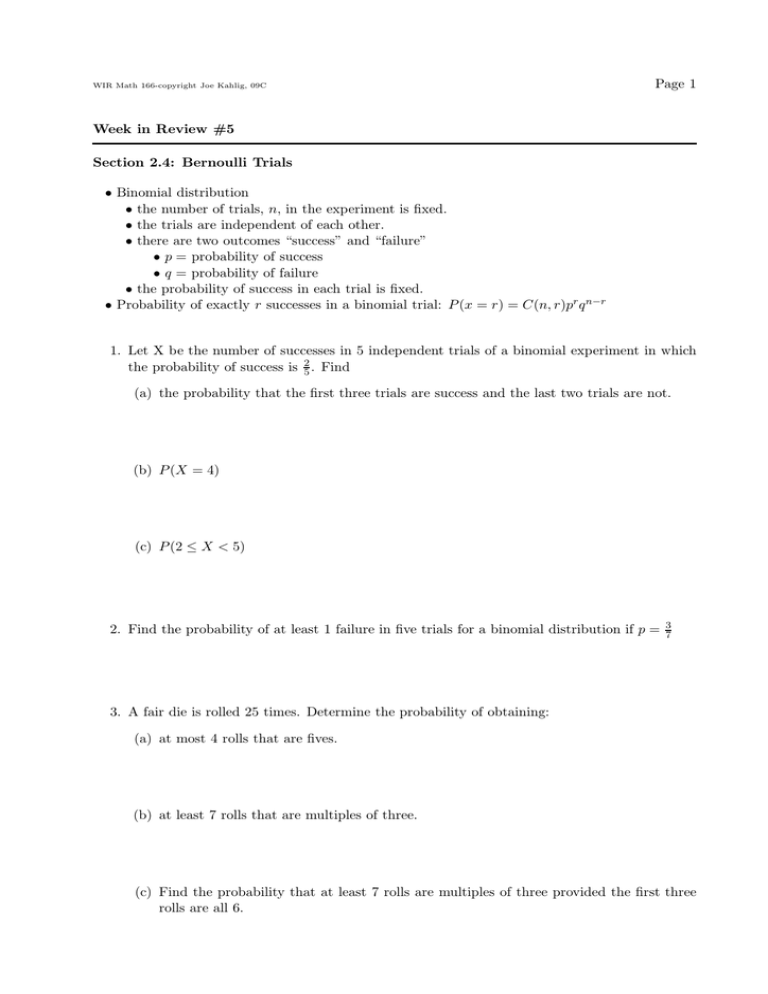
WIR Math 166-copyright Joe Kahlig, 09C Page 1 Week in Review #5 Section 2.4: Bernoulli Trials • Binomial distribution • the number of trials, n, in the experiment is fixed. • the trials are independent of each other. • there are two outcomes “success” and “failure” • p = probability of success • q = probability of failure • the probability of success in each trial is fixed. • Probability of exactly r successes in a binomial trial: P (x = r) = C(n, r)pr q n−r 1. Let X be the number of successes in 5 independent trials of a binomial experiment in which the probability of success is 52 . Find (a) the probability that the first three trials are success and the last two trials are not. (b) P (X = 4) (c) P (2 ≤ X < 5) 2. Find the probability of at least 1 failure in five trials for a binomial distribution if p = 3 7 3. A fair die is rolled 25 times. Determine the probability of obtaining: (a) at most 4 rolls that are fives. (b) at least 7 rolls that are multiples of three. (c) Find the probability that at least 7 rolls are multiples of three provided the first three rolls are all 6. WIR Math 166-copyright Joe Kahlig, 09C Page 2 4. The probability of an adverse reaction to a flu shot is 0.15. Flu shots are given to a group of 80 people. (a) Find the probability that 5 to 12 people will have an adverse reaction to the shot. (b) Find the probability that there will be 17 people with an adverse reaction to the flu shot if out of the first 10 people to get the shot exactly 5 had an adverse reaction. 5. A box contains 70 items of which 15 are defective. If 10 items are selected from the box, what is the probability that exactly 6 of them are defective. 6. Find the probability that in a group of 7 people that at least two of them were born in July. Assume that all months are equally likely. Section 3.1: Distribution of Random variables. • A random variable is a rule that assigns a number to each outcome of an experiment. • finite discrete: takes on a finite number of values(skips values). • infinite discrete: takes on an infinite number of values(skips values). • continuous: takes on any value in an interval. • a histogram is a probability distribution represented by a graph(chart). 7. Classify the random variable as finite discrete, infinite discrete or continuous and give the values of the random variable. (a) You toss a coin and X = the number of tosses until the first head occurs. (b) A football team plays twelve games in a regular season and X = the number of games the team wins. (c) X = the temperature of a fish tank in your house. (d) X = the number of minutes that you slept in your math class on a particular class day. Page 3 WIR Math 166-copyright Joe Kahlig, 09C 8. A box has 2 green, 2 red and 5 yellow balls. A sample of 6 balls are drawn without replacing the balls drawn. Let the random variable X be the number of yellow balls drawn. (a) Give the values of the random variable X. (b) Find the probability distribution of X. (c) Draw the histogram of X. (d) P (X = 4) = (e) P (X < 4) = 9. Draw the histogram for the probability distribution. X P (X = x) 2 0.3 3 0.1 5 0.25 7 0.35 Page 4 WIR Math 166-copyright Joe Kahlig, 09C 10. You pay $2.00 to play a game. The game consists of flipping two coins. If both coins are heads, then you get to spin the spinner on the left for the dollar amount that you win. If both coins are tails, then you get to spin the spinner on the right for the dollar amount that you win. All other results for the coins means that you lose the game. Assume that the sections in each respective spinner are equal. Let the random variable X be your net winnings when you play the game one time. What is the probability distribution for this game. 6 2 5 1 2 3 3 4 Section 3.2: Expected value. • Mean, Medain, Mode • Expected value(mean), E(X) = x1 ∗ p1 + x2 ∗ p2 + ... + xn pn • A game is said to be fair if E(X) = 0 11. Compute the expected value for the random variable X from problem 8. x 2 3 4 5 prob 10 84 40 84 30 84 4 84 Page 5 WIR Math 166-copyright Joe Kahlig, 09C 12. Compute the expected value for the random variable X from problem 10. x −2 −1 0 1 2 3 4 prob 1 2 1 12 2 15 2 15 1 20 1 20 1 20 If you play this game 10,000 times, what results would you expect? 13. A game consists of rolling a fair 8-sided die. The chart gives the payoff of this game. What should be charged so that this game is fair? Die roll 8 7 5,6 1 Payoff $12 $5 $2 get your money back 14. Compute the mean, median, and mode for the data set. 10, 12, 12, 14, 15, 16, 16, 22 Page 6 WIR Math 166-copyright Joe Kahlig, 09C 15. Compute the mean, median, and mode for the data set. data 10 12 20 24 30 frequency 20 12 5 7 12 16. Estimate the mean for this data set. data 1-8 9-16 17-24 25-32 frequency 8 10 15 20
